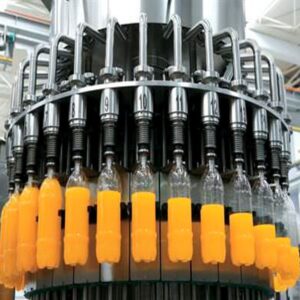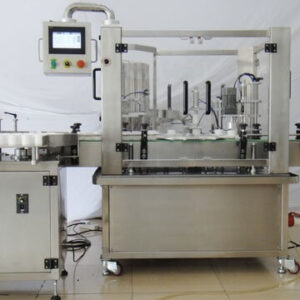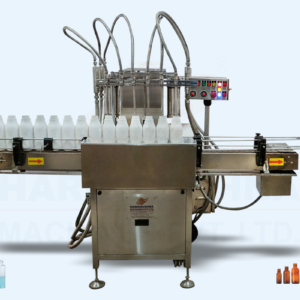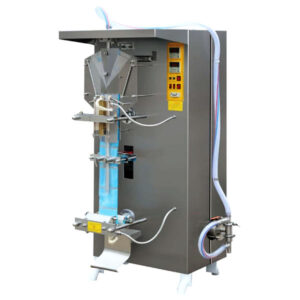Description
| Parameter | Specification |
|---|---|
| Machine Type | Automatic Bottle Filling Machine |
| Capacity | 1000-2000 bottles/hour |
| Bottle Types Supported | Various shapes and sizes |
| Filling Volume Range | 100ml – 2000ml |
| Filling Accuracy | ± 0.5% |
| Material | Stainless Steel 304 |
| Power Supply | 220V/380V, 50Hz/60Hz |
| Power Consumption | 5 kW |
| Air Pressure | 0.6-0.8 MPa |
| Air Consumption | 0.8 m³/min |
| Control System | PLC Control |
| Touch Screen Interface | Included |
| Conveyor Speed | Adjustable |
| Dimensions (L×W×H) | 2500mm×1200mm×1800mm |
| Weight | 800 kg |
| Certification | CE, ISO9001 |
A bottle-filling machine is a vital piece of equipment used in various industries, primarily in the food and beverage, pharmaceutical, and chemical sectors. Its primary function is to automatically fill bottles with liquid products efficiently and accurately. These machines come in various designs and configurations to accommodate different bottle shapes, sizes, and production capacities.
Typically, a bottle-filling machine consists of several key components, including a conveyor belt to transport empty bottles to the filling station, a filling mechanism such as a nozzle or pump to dispense the liquid product, and controls to regulate the filling process. Modern bottle-filling machines often incorporate advanced technology such as sensors and programmable logic controllers (PLCs) to ensure precise filling levels and to monitor production parameters.
The benefits of using bottle-filling machines are numerous. They increase production efficiency by automating the filling process, reduce labor costs, and minimize product waste by accurately dispensing the desired amount of liquid into each bottle. Additionally, these machines help maintain product quality and consistency, crucial factors in industries where precision and reliability are paramount. Overall, bottle-filling machines play a crucial role in streamlining production processes and ensuring the timely delivery of high-quality products to consumers.
Types of bottle filling machine machine
Gravity-Filling Machines: These machines use the force of gravity to fill bottles with liquid. They are suitable for filling thin or free-flowing liquids and typically feature a simple design with minimal moving parts.
Overflow Filling Machines: Overflow fillers are ideal for filling bottles with foamy or viscous liquids. The filling nozzles create a seal over the bottle opening, and excess liquid overflows into a reservoir, ensuring consistent fill levels.
Piston Filling Machines: Piston fillers use a piston mechanism to dispense precise amounts of liquid into bottles. They are suitable for filling thick or semi-viscous products and offer high accuracy and control over fill volumes.
Vacuum Filling Machines: Vacuum fillers remove air from the bottle before filling, creating a vacuum that draws the liquid into the container. This type of filling machine is commonly used for filling delicate or carbonated beverages to prevent foaming and oxidation.
Rotary Filling Machines: Rotary fillers feature multiple filling heads arranged in a rotary configuration, allowing for high-speed filling of multiple bottles simultaneously. They are suitable for large-scale production and offer high efficiency and throughput.
Net Weight Filling Machines: Net weight fillers measure the weight of the filled product rather than relying on volume. They are commonly used for filling products sold by weight, such as powders, granules, or solid items packed in bottles.
Applications of bottle filling machine machine
Beverage Industry: Bottle-filling machines are extensively used in the beverage industry for filling bottles with various liquids such as water, juice, soft drinks, alcoholic beverages, and sports drinks. These machines can handle different bottle sizes and shapes, from small PET bottles to large glass containers.
Pharmaceutical Industry: In the pharmaceutical sector, bottle-filling machines are crucial for filling bottles with medications, syrups, vitamins, and other liquid pharmaceutical products. These machines adhere to strict regulatory standards to ensure accurate dosing and product integrity.
Food Industry: Bottle-filling machines play a vital role in the food industry for filling bottles with sauces, oils, dressings, condiments, and other liquid food products. They help maintain product consistency, hygiene, and shelf life while increasing production efficiency.
Personal Care and Cosmetics: Bottle-filling machines are used to fill bottles with various personal care and cosmetic products such as shampoos, lotions, creams, and perfumes. They ensure precise filling volumes and prevent product wastage, enhancing product quality and customer satisfaction.
Chemical Industry: In the chemical sector, bottle-filling machines are employed to fill bottles with cleaning agents, detergents, solvents, lubricants, and other chemical products. These machines are designed to handle corrosive or hazardous substances safely and efficiently.
Agriculture and Horticulture: Bottle-filling machines are utilized in the agriculture and horticulture industries for filling bottles with fertilizers, pesticides, herbicides, and other agricultural chemicals. They help streamline the packaging process and ensure accurate dosing for optimal crop yield and plant health.
Functionalities of bottle filling machine machine
Precise Filling: Bottle-filling machines are designed to dispense precise volumes of liquid into each bottle, ensuring consistency and accuracy across multiple containers. This precision is crucial for maintaining product quality and meeting regulatory standards.
Adjustable Fill Levels: Many bottle-filling machines allow for adjustable fill levels, accommodating different bottle sizes and product requirements. Operators can easily adjust fill volumes to meet specific packaging needs, ensuring flexibility and versatility in production.
Multiple Filling Heads: Some bottle-filling machines feature multiple filling heads arranged in a linear or rotary configuration, allowing for the simultaneous filling of multiple bottles. This increases throughput and production efficiency, reducing cycle times and maximizing output.
Clean-in-Place (CIP) Systems: CIP systems integrated into bottle-filling machines enable automated cleaning and sterilization of the filling equipment between production runs. This helps maintain hygiene and prevents cross-contamination, especially in industries such as food, beverage, and pharmaceuticals.
Integration with Packaging Lines: Bottle-filling machines can be seamlessly integrated with other packaging equipment such as capping machines, labeling machines, and conveyor systems to create complete packaging lines. This integration streamlines the production process, improves efficiency, and reduces manual handling of bottles.
Diverse Product Compatibility: Bottle-filling machines are designed to handle a wide range of liquid products, including beverages, pharmaceuticals, food items, chemicals, and personal care products. They can accommodate various viscosities, temperatures, and packaging materials, ensuring versatility in production.
User-friendly Controls: Modern bottle-filling machines are equipped with user-friendly control interfaces, often featuring touchscreen displays and intuitive software. Operators can easily set parameters, monitor production progress, and troubleshoot issues, enhancing operational efficiency and productivity.
Safety Features: Bottle-filling machines incorporate safety features such as interlocks, guarding, and emergency stop buttons to protect operators and prevent accidents. These safety measures comply with industry regulations and standards, ensuring a safe working environment.
Frequently Asked Questions
- How does a bottle-filling machine work?
Bottle-filling machines work by transporting empty bottles to a filling station, where they are filled with liquid using a filling mechanism such as a nozzle or pump. The filling process is controlled to ensure accurate dosing and filled bottles are then moved to the next stage of the packaging line.
- What types of liquids can be filled using a bottle-filling machine?
Bottle-filling machines can handle a wide range of liquids, including water, juices, soft drinks, alcoholic beverages, oils, sauces, pharmaceuticals, chemicals, and more.
- What factors should be considered when choosing a bottle-filling machine?
Factors to consider include the type of liquid being filled, production volume, bottle size and shape, filling speed, accuracy requirements, space availability, and budget.
- How can I adjust the fill level on a bottle-filling machine?
Fill levels can typically be adjusted through controls on the machine, allowing operators to set precise fill volumes according to product specifications.
- Are bottle-filling machines suitable for small-scale production?
Yes, there are bottle-filling machines available that are designed specifically for small-scale or startup operations, offering flexibility, affordability, and ease of use.
- What are the maintenance requirements for bottle-filling machines?
Maintenance requirements may include regular cleaning, lubrication, inspection of components, and replacement of worn parts to ensure optimal performance and longevity of the machine.
- Can bottle-filling machines accommodate different bottle sizes and shapes?
Yes, many bottle-filling machines are adjustable and can accommodate various bottle sizes and shapes, including round, square, and irregular shapes.
- Are bottle-filling machines capable of filling bottles with hot liquids?
Yes, there are bottle-filling machines designed specifically for filling bottles with hot liquids, featuring components that can withstand high temperatures.
- How long does it take to set up and install a bottle-filling machine?
Answer: Installation times vary depending on the complexity of the machine and site-specific requirements, but it typically takes a few days to a couple of weeks to set up and install a bottle-filling machine.
- What safety features are typically included in bottle-filling machines?
Common safety features include emergency stop buttons, guarding, interlocks, and safety sensors to protect operators and prevent accidents during operation.





